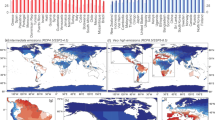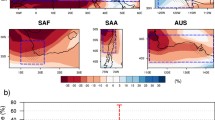Abstract
It is now widely recognised that the most significant impacts of global warming are likely to be experienced through changes in the frequency of extreme events, including flooding. This paper reviews physical and empirical arguments which suggest that global warming may result in a more intense hydrological cycle, with an associated increase in the frequency and/or magnitude of heavy precipitation. Results derived from enhanced-greenhouse experiments using global climate models (GCMs) are shown to be consistent with these physical and empirical arguments. Detailed analysis of output from three GCMs indicates the possibility of substantial increases in the frequency and magnitude of extreme daily precipitation, with amplification of the effect as the return period increases. Moreover, return period analyses for locations in Australia, Europe, India, China and the USA indicate that the results are global in scope. Subsequent discussion of the limitations of GCMs for this sort of analysis highlights the need for caution when interpreting the precipitation results presented here. However, the consistency between physically-based expectations, empirical observations, and GCM results is considered sufficient for the GCM results to be taken seriously, at least in a qualitative sense, especially considering that the alternative seems to be reliance by planners on the fundamentally flawed concept of a stationary climate.
Similar content being viewed by others
References
Browning, K. A.: 1990, Rain, rainclouds and climate,Q. J. Roy. Meteorol. Soc. 116, 1025–1052.
Bureau of Meteorology: 1984,The Estimation of Probable Maximum Precipitation in Australia for Short Durations and Small Areas, Bulletin 51, Australian Bureau of Meteorology.
Cubasch, U. and Cess, R. D.: 1990, Processes and modelling, inClimate Change: the IPCC Scientific Assessment, report prepared for the WMO/UNEP Intergovernmental Panel on Climate Change by Working Group I, Cambridge University Press, Cambridge.
Gordon, H., Whetton, P. H., Pittock, A. B., Fowler, A. M., and Haylock, M. R.: 1992, Simulated changes in daily rainfall intensity due to the enhanced greenhouse effect: implications for extreme rainfall events,Climate Dynamics 8, 83–102.
Hansen, J., Rind, D., DelGenio, A., Lacis, A., Lebedeff, S., Prather, M., and Ruedy, R.: 1988, Regional greenhouse climate effects, inCoping with Climate Change, Proc. 2nd North-American Conf. Preparing for Climate Change, Dec. 6–8, 1988, Climate Institute, Washington DC.
Haarsma, R. J., Mitchell, J. F. B., and Senior, C. A.: 1993, Tropical disturbances in a GCM,Climate Dynamics 8, 247–257.
Hay, J. E.: 1971, Precipitable water over Canada: II distribution,Atmosphere 9, 101–111.
Hennessy, K. J., Fowler, A. M., and Whetton, P. H.: 1993, GCM simulated changes in daily rainfall intensity and heavy rainfall events under an enhanced greenhouse effect,Extended abstracts Fourth Int. Conf. Southern Hemisphere Meteorology and Oceanography, Hobart 29 March-2 April 1993.
Hennessy, K. J., Gregory, J. M., and Mitchell, J. F. B.: in preparation, Changes in daily rainfall under enhanced greehouse conditions.
Houghton, J. T., Callander, B. A., and Varney, S. K. (ed.): 1992,Climate change 1992: the supplementary report to the IPCC scientific assessment, Cambridge University Press, Cambridge.
Houghton, J. T., Jenkins, G. J., and Ephraums, J. J. (eds): 1990,Climate Change: the IPCC scientific assessment, Cambridge University Press, Cambridge.
Kowalczyk, E. A., Garratt, J. R., and Krummel, P. B.: 1994,Implementation of a soil-canopy scheme into the CSIRO GCM-regional aspects of the model response, CSIRO DAR Tech. Paper No. 32, 62 pp.
Kundzewicz, Z. W., Rosbjerg, D., Simonovic, S. P., and Takeuchi, K. (eds): 1993, Extreme Hydrological Events: Precipitation, Floods and Droughts (Proc. Yokohama Symposium), International Association of Hydrological Sciences Publication No. 213, 459 pp.
McGregor, J. L., Gordon, H. B., Watterson, I. G., and Dix, M. R.: 1993,The CSIRO 9-level atmospheric general circulation model, CSIRO Division of Atmospheric Research Technical Paper No. 26.
Mearns, L. O., Schneider, S. H., Thompson, S. L., and McDaniel, L. R.: 1990, Analysis of climate variability in general circulation models: comparison with observations and changes in variability in 2 × CO2,J. Geophys. Res. 95(D12), 20469–20490.
Mitchell, J. F. B. and Ingram, W. J.: 1992, Carbon dioxide and climate: mechanisms of changes in clund,J. Clim. 5, 5–21.
Mitchell, J. F. B., Manabe, S., Meleshko, V., and Tokioka, T.: 1990, Equilibrium climate change — and its implications for the future, inClimate change: the IPCC scientific assessment, report prepared for the WMO/UNEP Intergovernmental Panel on Climate Change by Working Group I, Cambridge University Press, Cambridge.
Noda, A. and Tokioka, T.: 1989, The effect of doubling the CO2 concentration on convective and non-convective precipitation in a general circulation model coupled with a simple mixed layer ocean model,J. Meteorol. Soc. Japan 67, 1057–1069.
Oke, T. R.: 1987,Boundary Layer Climates, Routledge, New York.
Pitman, A. J., Henderson-Sellers, A., and Yang, Z.-L.: 1990, Sensitivity of regional climates to localized precipitation in global models,Nature 346, 734–737.
Pittock, A. B.: 1993, A climate change perspective on grasslands,Proc. XVII International Grassland Congress 1993, Auckland, 1053–1060.
Pittock, A. B., Fowler, A. M., and Whetton, P. H.: 1991, Probable changes in rainfall regimes due to the enhanced greenhouse effect,International Hydrology and Water Resources Symp. Preprints, Perth, 2–4 October, 1991.
Ramanathan, V., Cicerone, R. J., Singh, H. B., and Kiehl, J. T.: 1985, Trace gas trends and their potential role in climate change,J. Geophys. Res. 90, 5547–5566.
Rasch, P. J. and Williamson, D. L.: 1990, Computational aspects of moisture transport in global models of the atmosphere,Q. J. Roy. Meteorol. Soc. 116, 1071–1090.
Reitan, C. H.: 1960, Distribution of precipitable water over the continental United States,Bull. Amer. Meteorol. Soc. 41, 79–87.
Robinson, D. K.: 1987, Selection of design floods, in D. H. Pilgrim (ed),Australian Rainfall and Runoff: A Guide to Flood Estimation, Vol.1, The Institute of Engineers, Australia, Barton, ACT, Australia.
Ropelewski, C. F. and Halpert, M. S.: 1987, Global and regional scale precipitation patterns associated with the El Nino/Southern Oscillation,Mon. Weather Rev. 115, 1606–1626.
Ropelewski, C. F. and Halpert, M. S.: 1989, Precipitation patterns associated with the high index phase of the Southern Oscillation,J. Climate 2, 268–284.
Schlesinger, M. E., and Mitchell, J. F. B.: 1987, Climate model simulations of the equilibrium climate response to increased carbon dioxide,Rev. Geophys. 25, 760–798.
Smith, D. I.: 1993, Greenhouse climatic change and flood damages, the implications,Climatic Change 25, 319–333.
Stephens, G. L.: 1990, On the relationship between water vapour over the oceans and sea surface temperature,J. Climate 3, 634–645.
Tegart, W. J. McG., Sheldon, G. W., and Griffiths, D. C. (eds): 1990,Climate Change: the IPCC impacts assessment, Australian Government Publication Service, Canberra.
Wigley, T. M. L. and Raper, S. C. B.: 1992, Implications for climate and sea level of revised IPCC emissions scenarios,Nature 357, 293–300.
Windelband, M., Sausen, R., and Cubasch, U.: 1993, Changes in convective height due to global warming, in G. J. Boer (ed),Research Activities in Atmospheric and Oceanic Modelling, Report No. 18, WMO: 9.10–9.12.
Whetton, P. H., Fowler, A. M., Haylock, M. R., and Pittock, A. B.: 1993, Implications of climate change due to the enhanced greenhouse-effect on floods and droughts in Australia,Climatic Change 25, 289–317.
WMO: 1986,Manual for estimation of probable maximum precipitation. 2nd edn, Operational Hydrology Report No. 1 (WMO, No; 332), World Meteorological Organization, Geneva.
Author information
Authors and Affiliations
Rights and permissions
About this article
Cite this article
Fowler, A.M., Hennessy, K.J. Potential impacts of global warming on the frequency and magnitude of heavy precipitation. Nat Hazards 11, 283–303 (1995). https://doi.org/10.1007/BF00613411
Received:
Revised:
Issue Date:
DOI: https://doi.org/10.1007/BF00613411




